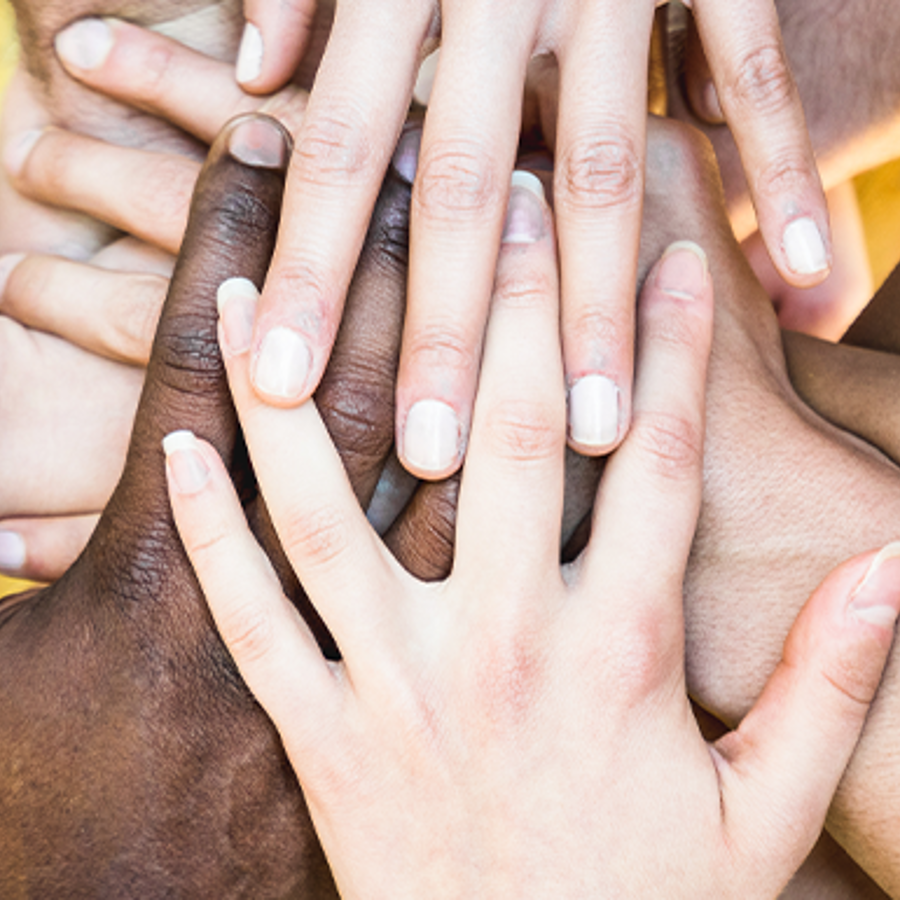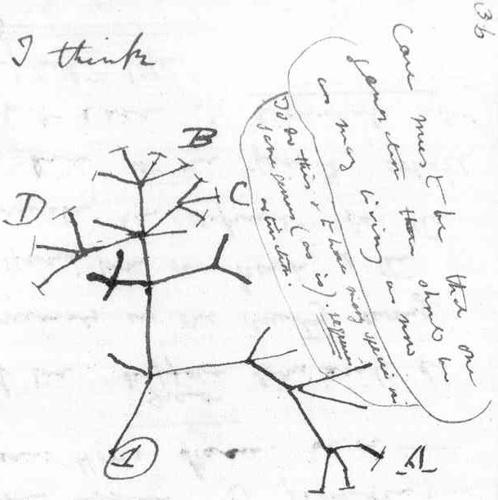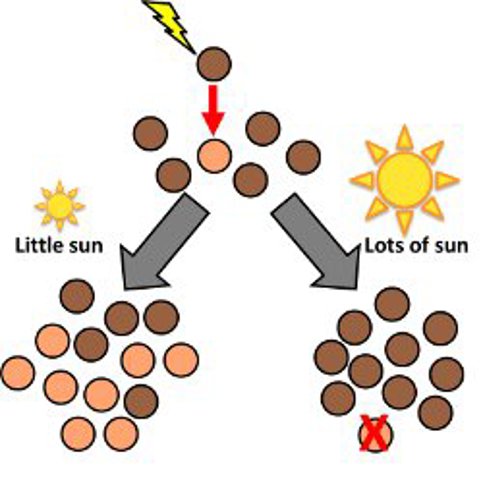
If humans have a common ancestor, why do we have different color skins?
July 8, 2015

- Related Topics:
- Pigmentation traits,
- Skin pigmentation,
- Human evolution,
- Evolution,
- Mutation
A graduate student from Papua New Guinea asks:
"If humans have a common ancestor, why do we have different color skins?"
Even though there are lots of skin colors around now, all of our earliest ancestors had dark skin. There are a couple of reasons for the diversity we see today.
First, the instructions for making us, the genes in our DNA, aren’t written in stone. In each generation, a small number of changes happen in everyone’s DNA. So at some point someone somewhere must have had a change (or mutation) that caused his or her skin to lighten.
The second reason is that there are many different genes that play a part in what color skin we have. This means there’s a range of different skin colors in any group of people. Some are darker and some lighter.
Imagine two people with similar skin color have a child. They might, by chance, happen to each pass on mostly lighter versions of their skin color genes to their child. Now that child is even lighter than the parents! (This would work in reverse if they happened to pass on mostly darker colored versions).
So that explains why one person or another might have lighter colored skin. What it doesn’t explain is why whole populations (like those in Northern Europe) have lighter skin.
The Yin and Yang of Sun
Simply put, the major reason that whole populations of people have different skin colors is because there are differences in sunlight across the world. Places like Hawaii get a lot of sunlight while places like Iceland don’t. And, people need different types of protection depending on the sunlight levels where they live.
Our very earliest ancestors lived in Africa, a super sunny place. There’s a nutrient in our bodies called folate that the sun’s rays break down. If too much is broken down people get sick. Our ancestors in Africa had dark skin to protect their folate from the sun.
After a while, some humans moved from Africa to Europe. Europe isn’t very sunny which means they no longer needed dark skin to protect their folate. And in fact dark skin turned out to be bad for them there.
Humans get an important vitamin from the sun, vitamin D. In not very sunny places, if you have too dark of skin you don’t get enough vitamin D. So eventually the skin color of people in Europe got lighter so they could stay healthy.
But the necessary DNA changes did not happen because of the decreased sunlight. And it didn’t happen overnight either! Changes in a population like this often happen over time through something called natural selection.
Processes like natural selection take a long time. Think about the tread wearing down on your bike tires, or a younger sibling getting taller. You don’t notice small changes day by day, but they’re happening.

Darwin’s Slam-Dunk Theory
Over 150 years ago Charles Darwin spent many years studying creatures all over the world. He was spellbound by how many types of animals there were. And was puzzled by how they came to be.
In 1859 he published his now famous book called “On the Origin of Species.” In it he introduced the idea of natural selection. Natural selection explains how all the types of animals came to be.
We encounter examples of natural selection everyday. Think germs becoming resistant to antibiotics or cancers that no longer respond to treatment.
Basically, natural selection is how groups of living things get better suited to their surroundings. With enough time natural selection can even lead to new types of animals. It also explains how humans with different skin colors can share a single ancestor.

But How Does It Work?
In Darwin’s time people really didn’t have a clue about how natural selection could work. I mean, the fact that a chicken and a penguin (or even a velociraptor) are distant cousins is sort of unbelievable! But nowadays, we have a pretty good idea of how it can happen.
Like I mentioned, all living things have something called DNA, which is passed from parents to offspring. DNA is the code of life and provides instructions for genes.
Each generation, small changes in DNA can occasionally tweak the DNA and affect how a gene works. These are called mutations, and they happen pretty randomly.
If an altered gene is a lot better than the original (i.e. helps that individual survive better and have more kids), then over time it can spread through a population. This is because people with the change have more kids than people without it. After many generations, individuals with the new mutation will have replaced those with the older DNA. This is the process of natural selection, and can occur either on new mutations, or on a mutation already present in an individual in a population.
Now let’s think about natural selection and human skin color. About 40,000 years ago, when some people moved from Africa to Northern Europe, their new home had a lot less sun. And perhaps people didn’t make enough vitamin D.
After some time, someone had a random DNA mutation that made his or her skin tone lighter. This person now had an advantage because it was easier to make more vitamin D. This led to better survival and more children for this lighter skinned person.
After many, many, many generations, the light version of the gene spread so that everyone living in Northern Europe had it. (This can happen because in each generation people with the lighter skin version of the gene tended to have more kids than those without it).

Again, these processes take a long time, thousands and thousands of years. Not only does just the right change have to occur at just the right time, there also has to be enough time to spread!
From genetic analyses we now know that DNA changes leading to lighter skin pigmentation happened at least 3 separate times. Once in Europeans, once in East Asians, and once in our distant relatives, the Neanderthals.
There’s a great book called “Before the Dawn” by Nicholas Wade that has a lot more details on this sort of human history. It also touches a lot on how natural selection has shaped how we are as a species.
The Future of Human Skin Tone
One reason why people from Northern Europe have very different skin pigmentation compared to people from sub-Saharan Africa is that they are very far apart. It was very difficult for people from one area to move to the other!
But humans have always moved around. Migration and intermixing has led to some of the variety of skin color we see around the world. For instance, we know that most Ethiopians and Somalis have a mixture of European and African ancestry. And Mexican Americans have a mixture of Native American, European and African ancestries.
Of course, travel is much easier now. And some places (like the U.S.) are melting pots of people from a wide range of geographic ancestries. It will be interesting to think about whether one-day skin color will become even more uniform, as more people of different geographic ancestries are having children (click here to read more on this).
With so many advances in technology, our skin tone is no longer a reflection of where we live. But, at least we are also wiser about dealing with levels of sunlight that don’t jive with our natural skin tone (ie using vitamin supplements and sunscreen).
Read More:
- PBS: Natural selection turned grizzly bears into polar bears
- Ted talk on human skin color
- Smithsonian magazine: Skin color is only skin deep
- HHMI Biointeractive: The biology of skin color

Author: Mia Jaffe
When this answer was published in 2015, Mia was a Ph.D. candidate in the Department of Genetics, studying functional genomics using yeast in Gavin Sherlock’s laboratory. She wrote this answer while participating in theStanford at The Tech program.
 Skip Navigation
Skip Navigation
